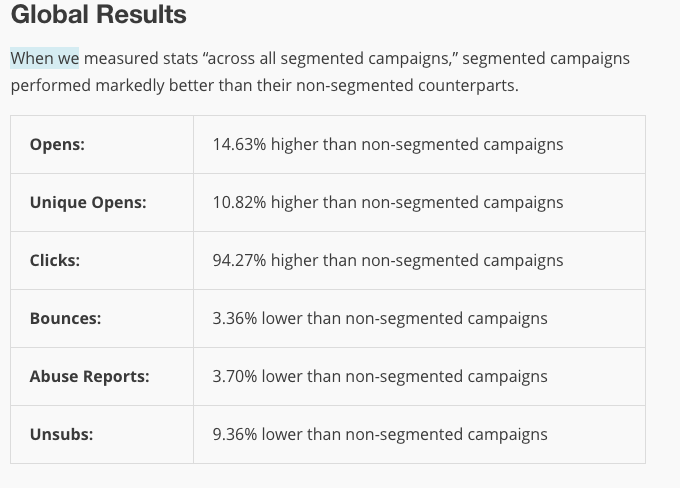
The Cheeky Monkey Media Blog
A few words from the apes, monkeys, and various primates that make up the Cheeky Monkey Super Squad.

How to Create Email Campaigns that Work
 February 1, 2017 / Treena Bjarnason
February 1, 2017 / Treena Bjarnason
Email marketing has the potential to have the highest return on investment (ROI) of all your marketing efforts.
According to the 2016 State of Email Report published by Litmus, email has an ROI “of 38-to-1 on every dollar invested.”
That’s pretty significant. Think about it…
The average salary for an email marketing specialist in Canada is about $45,000.00 / year, depending on location. For simplicity’s sake, let’s consider that your email marketing investment (noting that you probably end up spending a bit more on automation systems and producing content).
So, with a $45,000.00 initial investment, you could, based on an ROI of 38-to-1 expect to see a return of $1,710,000.00.
That doesn’t mean you should go out and hire an email marketing specialist and expect a 1-million-dollar return on your investment. Don’t do that.
If you don’t remember anything else from this guide, remember this:
Don’t do email marketing just because it’s the thing to do and has (statistically) the highest ROI.
In fact, if you attempt to do email marketing without first determining your objective and setting out a strategy, you may very well lose money.
Email Marketing Basics: Define Success
We all want our emails to be opened and shared. Just like we all want our social media posts to get liked, shared, retweeted, and commented on. Right?
Of course we do!
But do these actions mean success for our organization? While they might contribute to this success — more social shares mean more eyes on our content, which means a greater likelihood of more people completing the CTA — at the end of the day, these metrics are not as indicative of success as CTA clicks.

For example, everyone loves a cat meme, except maybe people that don’t like cats, but I digress. Sometimes getting a cat meme is fun.

Moreover, there is nothing wrong with strategically used memes and gifs. Nevertheless, I argue that these images only work when and if they are used strategically to gently ‘push’ the reader towards completing a predetermined action after they open and read the email.
Let me explain…
1. Set an Objective for Your Email Marketing Efforts
Before you send an email to your email list, actually, before you even think “email list,” you need to think about what you’d like to achieve with your email marketing initiative:
- Do you want to get new leads?
- Do you want to sell a service or product?
- Do you want to build a relationship with your community?
- Do you want to build brand awareness?
To avoid setting a vague, and almost certainly unreachable objective and associated goal, you will need to define your email marketing goals using SMART. In other words, your goals need to be:
Specific
Measurable
Agreed Upon
Realistic
Time Based
You will need to take the time to outline exactly what you want to achieve and do (i.e. send 2 email campaigns, 6 to 4 email segments), in what time period (i.e. 6 months apart), and what you want to get out of it (i.e. 10 new clients that each purchase at least $1000.00 from us).
In addition, you will need to make sure this specific, time-based, and measurable goal, is realistic given your organization’s larger context and that everyone in the organization knows what you are trying to achieve and how.
Client Example:
Last spring, we started working with a local HVAC company that hadn’t used email marketing before. They weren’t sure exactly what results they could expect from the initiative, but they had heard that email marketing has a great ROI. They wanted to try it to promote an upcoming series of rebate offers.
The Objective:
To promote a series of upcoming rebate offers.
Goal:
To send out 5 or 6 emails to existing clients over a one-and-a-half month period letting them know about the available rebate offers and encouraging them to schedule an estimate. As you can see, the goal was specific, measurable, and time-based.
Also, because this was a new initiative for the client they felt that even 1 or 2 sales as a result of the campaign would be a sufficient ROI to get them to pursue this channel further. This clarification the goal made it specific, realistic, measurable and agreed upon by all parties.
The Time Line:
Friday, July 13th, 2016 to Sunday, August 31st, 2016
2. Email Marketing Needs A Clear Plan: Outline the Process
Once you have a clear objective and well-defined goal for your marketing efforts, or at least you marketing campaign, you need to outline your plan of action.
Building the List – The CTA
For many, this starts with designing a call to action (CTA) that will capture email addresses that they can then send emails to do.
STOP
In Canada, according to CAN-SPAM laws, users must complete a double opt in when they sign-up.
Now, that we’ve taken care of that important piece of information, let’s talk about how you can entice prospective clients and members to join your list.
This is where knowing what you want to get out of your efforts and what you want your current or prospective clients to do becomes really important.
You know what you want. Now, you need to decide what getting that wish met means to you.
What are you going to offer your client or prospective client in return?
- Will it be a discount?
- A valuable piece of content or information?
- Priority service?
Essentially, you need to create a CTA that clearly outlines the benefit your (prospective) client will receive by signing up for your list, and what they can expect once they sign-up (i.e. one email a month or hundreds of emails a day).
Building the List – Wait! What about the Journey to the CTA?
I really love Walter Chen’s blog on InvisionApp, “Designing A Call to Action to Grow an Email List.” If you’re currently building your email list, I strongly suggest you take the time to read through the blog. The key point to, however, is to consider how and when you ask your (prospective) client for their email address:
“One of the best ways to do this [get people to try your product for the first time]: create a user flow that allows your content to first build the user’s trust, and place your call-to-action boxes more strategically.”
You can’t just ask people for their email address, well, I guess you could, but it probably won’t get you very far.
In fact, you’ll probably get a reaction that looks a little bit like this:

In dogs, this reaction is referred to as resource guarding (it’s not one you want to encourage), in humans, this is a natural reaction to too many people asking for our email addresses and then spamming us with useless content.
If however, you take the slightly longer approach and build trust with your (prospective) client by giving them a sense of your personality and giving them valuable content on their way to your call to action (where you ask for their email address) in exchange for something very valuable, you’ll get a reaction a little bit more like this:

Either this dog really likes his owner, or, he’s getting a delicious steak in exchange for his stash of toys.
When it comes to humans, you want them to give you their email address in exchange for that steak, err I mean, valuable content, discount, or promotional offer. Then, once you’ve wow’ed them with your amazingness, you want them to bring you all their work, kind of like the golden retriever in the image above.
And, in case it’s not obvious, I’m a bit of a dog person. Just a little bit, but I digress.
Once You have the List – The Welcome Email
You have the email address, now what? USE IT RESPONSIBLY! DELIVER WHAT YOU SAID YOU WOULD DELIVER. Start with a welcome email.
In “A Beginner’s Guide to Successful Email Marketing,’ Nathan Hagen explains that
“The initial follow-up email should be sent immediately as a way to introduce yourself and detail what you plan on doing with your new subscriber’s email address.”
In other words, say hi and welcome them into your community. More importantly, if you’ve promised something, like a download or discount coupon, give it to the subscriber right away.
Don’t make them wait. It’s rude, it and doesn’t serve you any practical purpose except to irritate your email subscriber, potentially prompting him or her to unsubscribe.

Back to our Client Example
Our HVAC client already had a list. When the company got a new client they asked if they would be willing to share their email addresses. We used this list for our campaign. Our first email explained the rebates available to the clients and the fine print associated with them.
- We sent 248 emails and 193 of those emails were opened. That’s a 69.4% open rate, considerably above the 19% industry average.
- We got 6 unsubscribes, which, while not great, is no cause for concern, especially given that this was a new initiative.
- The click rate was 4%, again above the industry average that sits at 2.5%.
- More significantly, this initial email resulted in 5 calls and 9 emails (a 5.6% email response conversion rate) and 8 scheduled appointments (a 3.2% appointment schedule conversion rate), which put us well above the modest goal of 1 or 2 appointments.
As with any email marketing campaign, we ran a test on this email.
- The first email variation didn’t include a description for the rebates.
- The second email variation included a description of the rebates.
While the open rate on the first test was higher, the click rate on the email with descriptions was better. This let’s us know that for future emails to this segment, we would want to include more descriptions.
Once You have the List – Subsequent Emails
After you send the first email, you want to make sure that every subsequent email offers value and delivers on the promise you made on your call to action and your welcome email.
When outlining which emails you will send, how many, and when, you will want to consider:
Consistency: You want your emails to be recognized as coming from you and your brand. Thus, you want to make sure are making use of your logo and brand colors.
Tone and Style: Let your personality shine through. People signed up because they like you, so be you. The tone and style of your email should also be, you guessed it, consistent with the tone and style of the rest of your communications.
Personal: While email marketing needs to be a bit more formal than, say social media, it still needs to be personal and friendly. If at all possible, have the email come from a specific person and email address.
When and How Often You Send Emails: Test when and how often you send emails. If you’ve promised to send a certain number, send a survey to ask clients if they like the number of emails they receive, or if they would like more or less.
Back to Our Client Example
When I introduced the campaign Cheeky Monkey Media put together for our HVAC client, I indicated that we were testing whether 5 or 6 emails worked better.
It turns out that neither option was the right combination. When we reviewed the results, we noticed that while the first 4 emails got email or phone call responses, we also saw an increase in unsubscribes after the 2nd email, which led us to believe that the magic number, at least for this company, was 2-3 emails per campaign.
3. Segmentation = Email Marketing Success
*Psst — Throughout this blog I assume (I know, shame on me) that you have a really good understanding of who your clients and email subscribers are. If you don’t, make sure you take the time to conduct buyer/user persona research or have an experienced team do it for you.
According to MailChimp, one of our favorite email automation software systems, the results in favor of segmenting email marketing lists are staggering. Just look at the results comparing the performance between segmented campaigns and non-segmented campaigns (updated on January 3rd, 2017):

In case you can’t see the image, here are the results again:
- Opens: 14.63% higher than non-segmented campaigns
- Unique Opens: 10.82% higher than non-segmented campaigns
- Clicks: 94.27% higher than non-segmented campaigns
- Bounces: 3.36% lower than non-segmented campaigns
- Abuse Reports: 3.70% lower than non-segmented campaigns
- Unsubs: 9.36% lower than non-segmented campaigns
Knowing that segmentation works is all well and good, but how should you segment?
Andrew Raso’s Kissmetrics blog “10 Quick and Easy Email Marketing Segmentation Strategies to Try Today” suggests segmenting by:
- Demographics (age, gender, position, etc)
- Survey or Quiz results
- Email Engagement
- Geographic Area
- Past Purchases
- Amount Spent
- Position in the Sales Funnel
- Website Behaviour
- Time Since Last Purchase
- Personal Interests
Sophia Bernazzani’s Hubspot article, “30 Ways to Slice Your Email Database for Better Email List Segregation,” goes even further and suggests segmenting by:
- Education Level
- Industry
- Buying Frequency
- Content Topic
And the list goes on. Basically, the ways in which you can segment is practically endless. If you can imagine a difference, you can probably segment based on that difference.
Should You Always Segment Your Email List?
Should you segment, just for the sake of segmenting? No.
Segment When Your Email List is Large
If your list size is in the 1000s or 10,000s, you definitely need to segment. In fact, any time you have a 100 or more individuals on your list, it’s probably worth your time to segment your list.
What About Super Small Lists
But what if you have a super small list, less than 100? This is where things get a bit tricky. Will the ROI you get from segmenting your list be worth the extra 3+ hours it will take you to segment your list and create different emails for each list?
Segment When Your Email List Comes from Different CTAs
In these situations, it depends on the content you’re sending. If these individuals signed up through different calls to action (that promised different things), you have to segment; otherwise, you’re going back on your word and breaking your subscriber’s trust. Not a good start to a relationship.
The Mulan dragon giph might be cute, but your email subscribers won’t think you lying to them is cute.
Segment When An Offer Doesn’t Apply to Everyone on the List
Let’s say you have a discount offer on cat food. If you have a list of 100 clients, and not all of those clients have cats, would you send the offer to all your clients? Probably not, you’d probably send the cat food discount offer to your cat people, your dog treat discount to the dog folks, and your freeze-dried mouse special to the snake people.
Just imagine what would happen if you sent the freeze-dried mouse special to the 6 people on your list that own mice as a pet?
Don’t do it. Just don’t.

Don’t Segment if You’re Sending General Information to a Very Small List
However, if you’re sending general information or content to your whole list and your email list is less than 100 people, the ROI you’ll get from segmenting based on, say position, most likely won’t be worth sending a slightly different email to each segment.
4. Test Your Email Marketing Campaigns
Remember above when I said that email can have an ROI of 38-to-1?
You usually don’t get that kind of ROI on the first campaign you do for yourself or for a new client if you’re an agency.
Rather, you need to test and fine tune your email campaigns.
Like with segmentation, if you can think it, you can test it. Usually, email marketers will test things like:
- Subject Lines
- Preview Text
- Email Copy
- Images
- Segment Types
- Number of Emails
- How Much Information is Included
- When Emails are Sent
- Design
Truly, the list is endless. In the client examples I mentioned above, we focused on testing the amount of detail in email content (and found that more was better — who knew!) and the number of emails (in this case, we found that less is more).
Could we have tested other things, like subject line, preview text, and CTA color/wording to name just a few? Absolutely. But not all at once.
General Rule: Test 1 Thing at a Time
When testing email campaigns, you want to test one thing at a time.
Yes, I know, we technically tested 2 things on the example I gave above. We cheated a little bit by testing the number of emails on the campaign as a whole and testing the amount of detail in the first email. While this may have skewed our results for the whole campaign slightly, the things we tested were separated enough to not disqualify the results of either.
Identify What Success Looks Like Ahead of Time
Remember the client example I describe above, where I noted that even though the open rate for the email with less description was higher, we picked the email variation (in this case the longer description) which had the higher click-through-rate as the winner?
Why was the click-through-rate more important to our test than the open rate?
Whenever you run a test, you need to know what success means. This takes us back to our very first point, outlining your objectives and defining SMART goals. Of course we wanted people to open the emails we sent them. However, it was more important to us that people engaged with the content and clicked on a CTA or contacted the HVAC company.
Thus, success for our client, and for us, was defined as more conversions (clicks on email content as well as call and email inquiries).
Consider Quality of Leads
Beware of the #vanitymetrics I mention above. I find it easier to think of this in terms of blog posts, but it applies to emails as well.
Let’s say you have a super click-baity blog post title. As a result, thousands of people click on the link and visit your site. That’s great right? Lot’s of site visitors = success.
Not exactly.
If those thousands of visitors spend 5-10 seconds on your site and bounce off, they are, for all extents and purposes, utterly useless to you.
The same thing happens with your email. Let’s say you’re testing an email subject line. If 85% of your subscribers open it, and 40% promptly unsubscribe, and only 1 person contacts you, have you succeeded or do you need to go to the drawing board?
Although your open rate is good statistically speaking, you still need to go back to the drawing board and consider looking into the subject line itself and the content:
Is the subject line clickbait? If it has nothing to do with the contents of the email than it doesn’t matter how effective it is at encouraging email opens.
Maybe your subject line is good, in that while it doesn’t match the content, it promises to deliver what you said you would deliver when people signed up for the email. Fix your content, make it fit your subject line. Come on people.
If neither your content or your subject line deliver what you promised to deliver then you have a huge problem. I’m serious. Go back, reread this blog, and consider these sage words of advice from Nathan Hangen:
Getting into someone’s inbox is like being invited to their home for dinner. If they ask you to take your shoes off, you respectfully do so. It’s the same with email marketing, so before we begin I’d simply like to remind you to be on your best behavior at all times and remember…you’re in their house.
In other words, don’t fu@& it up if you want to:
- Stay for dinner, and,
- Be invited back.
Seriously people. RESPECT your subscribers.
Final Thoughts
I’m sure we’ve all, myself included, sent an awful marketing campaign in the past. Mistakes happen. But they don’t need to happen twice. We know better. More than that, we all know what it feels like to be inundated with more content than we could possibly consume in a lifetime even if it was good content. So, treat other people’s inboxes the way you would like your inbox to be treated.
And, if you still feel stuck after giving these steps a try and iterating on the test you run, or just don’t have the time and energy to do it yourself, give me and the rest of the monkeys at Cheeky a shout. Emails us at [email protected]. We’re always happy to help.